Do you have a pile of old photos and can’t quite figure out when a certain picture was taken? Anyone who tries to date and organize photos has had this dilemma, whether you are a do-it-yourselfer or a professional photo organizer.
Recently we asked members of the Association of Personal Photo Organizers what tips and tricks they use to date enigmatic Photos. We think you will find their answers extremely helpful.
Photo Detective Tools
Before you get started it can help to have some tools handy…your photo detective bag of tricks as it were.
- A good magnifying glass or jeweler’s loop (If the photo is already digitized, the zoom function will be your friend.)
- Google or your favorite search engine
- Books or websites about fashion, hairstyles, photo types (Check out the selection offered by Maureen Taylor, The Photo Detective.)
- A family timeline of important dates and events
Photo Detective Tips
Here are some of photo detective tools that the APPO experts use on a regular basis.
Obvious Clues
If you get lucky, the back of the photo can give clues to location or date. If you are really lucky someone has written down identifying information (people, place, event, date). Congratulations, you have just won the photo detective jackpot!
In some cases, a developing date is printed on the back or in the border on the front. A word of caution – machine printed dates on photos are the date the print was developed, not the date the photo was taken. One obvious example would be a Christmas photo dated January 1952 but was probably taken during Christmas of 1951. I have had clients reprint an old scan which then got mixed back into their print collection. The photo was obviously from the 1940s but the developing stamp on the back said May 2015.
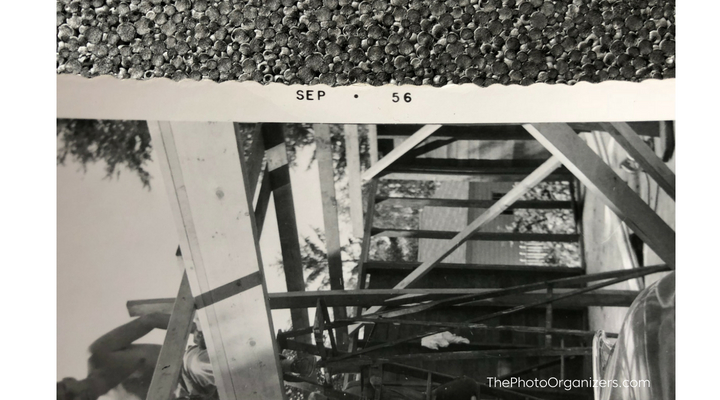
Many photos from the 1950s have the developing date printed in the margin on the front of the print.
Sometimes the date taken is not so obvious. When we still used actual film in our cameras, many people did not get it developed right away. When only 4 or 5 photos were taken at an event, often the film contained several events before it was developed. Remember the date on the back is the date developed.
Some photos taken with digital cameras and then printed may have date stamps on the front of the printed (or digital) photo. Take this date with a grain of salt. Just like the blinking clock on a VCR, many people never correctly set the date on their camera.
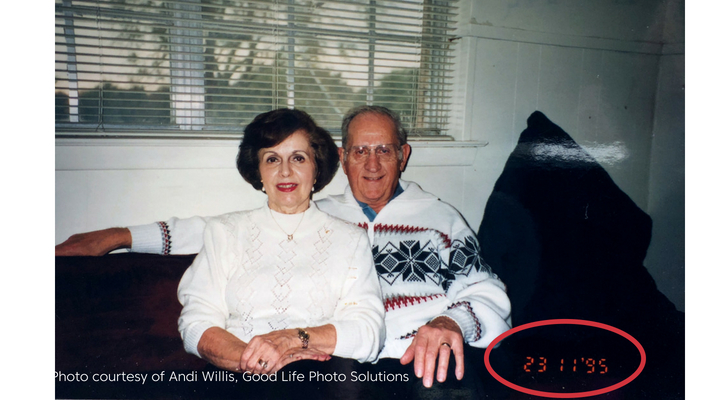
Be careful. That date stamp may not be correct.
Physical Clues
Look at the size, shape, and paper of the photo itself. Major developers like Kodak have changed their style over the years and these can be a great clue to the era in which a photo was developed.
Here are some online resources that you can use to identify the age of a print by its type and paper among other characteristics.
Identifying the Era of a Photo By Its Type – primarily for photos prior to 1903
Brand Stamps
History of Evolution of Kodak Logo
Kodak Colour Negative Film and Colour Print Making Materials and Processes
Ektacolor Paper Backprint Chronology
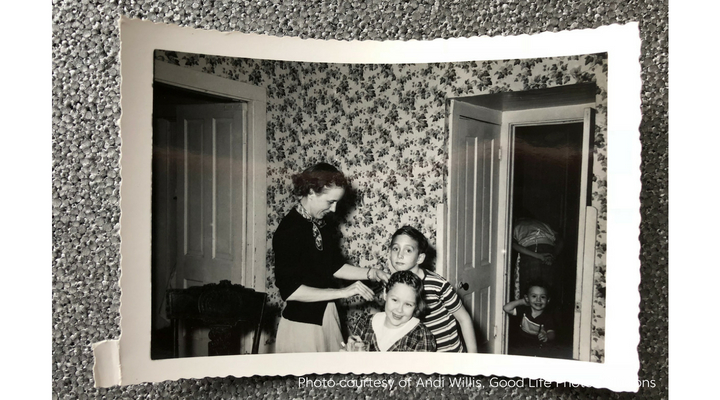
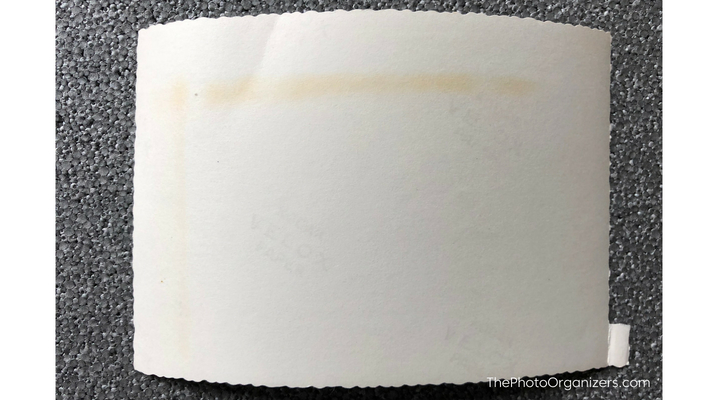
Several physical clues point to a date of the 1950s for this photo – the deckled (scalloped) edges, the Kodak Velox paper and the fact that it came bound in a small spiral-bound book from the developer (hanging chad on the side).
Slides will also have a date stamped on the paper or plastic mount. But remember that this is the developing date, not the date the photo was taken.
Kodachrome/Kodak slide mounts
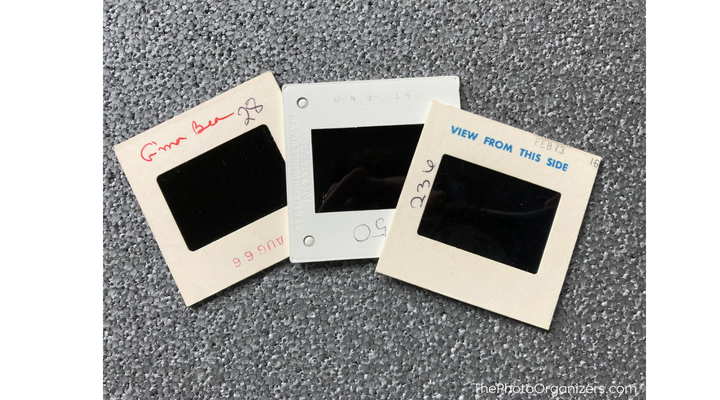
Date stamps on slides vary by date, film type, and developer.
If your photos are in the original developing envelope, check it for dates. This will give you a time when the photo was developed. It may even have an address or phone number of your family member on it which could aid your search.
For professional photographs, research the photographer to find out when they were active.
Happy Birthday To You
Count the candles on a birthday cake. Keep in mind that some families “add one for good luck” and some people have multiple birthday parties each year.
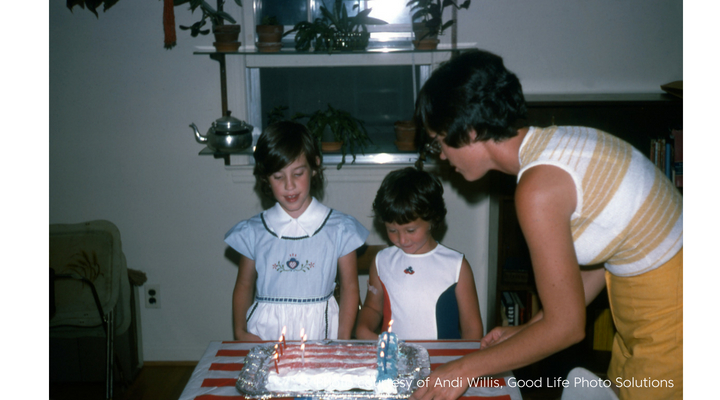
Counting candles on the cake can help. This one is a little confusing if you didn’t know that these two little girls always celebrated their birthdays together. Eight candles on the left for the girl on the left and five candles on the right.
Sandra Williams, Infinity Photo Solutions
“I (have) counted candles on a cake to determine the person’s age, used a magnifying app on my phone to read the name of the university on a diploma, and googled an obituary to find a date of birth.”
Car Hints
Look for a year on a license plate.
What is the make and model of the car? This can help pinpoint decades.
- Cars in the 1950s
- Talk to a local car enthusiast or dealer.
Study the state/province on the license plate and google images for license plates for those years
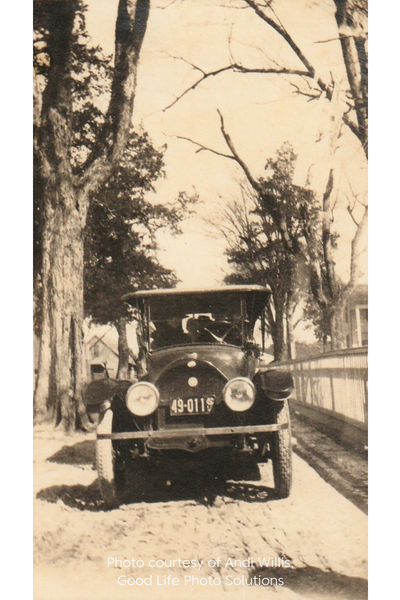
A little research on the type of car and the license plate could give us an approximate date for this family’s first car.
Kathy Stone, Calgary Photo Solutions
“I was looking at old photos online of Michigan Tech campus to see if the photos I was sorting were taken there and using a magnifying glass on old photos to see license plate and shape of the grill on the truck in different photos.”
What’s in the Background
Use a magnifying glass to look for anything in the background that may give clues to the date. Some ideas are:
Calendars in the photo will give you a general time frame to consider.
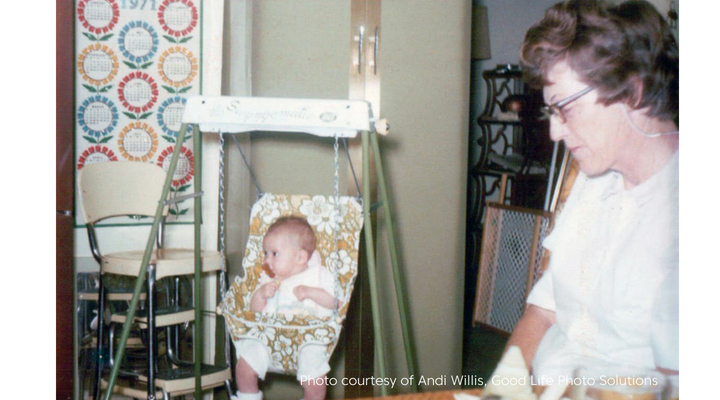
The calendar in the background leads us to the conclusion that this photo was taken in 1971.
Look at the headlines of newspapers or magazines in the photo, then google the headline.
A certain TV show or newscaster on a TV may help you narrow down a date.
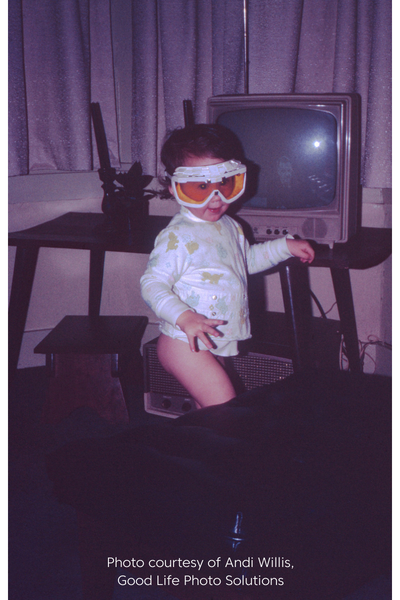
Is that Walter Cronkite in the background? You could google a picture of him and guesstimate the time period.
Research dates of sporting events by the teams playing on the TV in the background.
Zoom in and look for any hand-written notes, such as the label on a cradle in a hospital nursery.
Laura Woolsey, Memory Forward
“If I had a nickel for every birthday candle I’ve counted! Kitchen calendars with just the month and day can help and I have used Google to find the year that it could have been.“
Location, Location, Location
In outdoor shots, look for house number or street address, to match with years lived in a location.
Look at the shape of a door, the finish on the house, the type of porch, the style of windows to match an unknown photo with a known photo or to fit into a known chronology.
Look for words or logos on advertising signs to pinpoint a location and/or date.
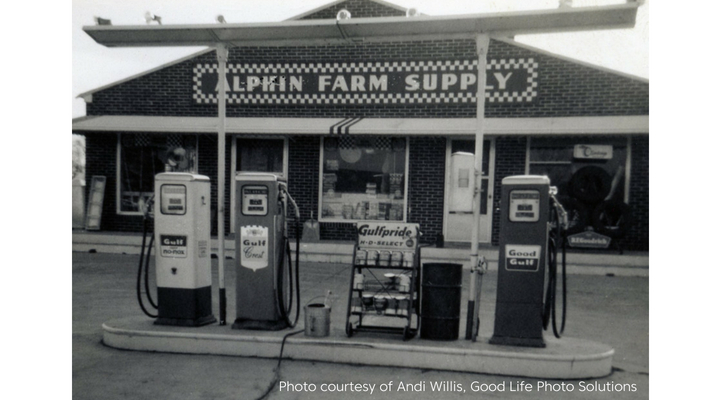
To date this photo, one could google Gulf gas pumps and logos to find the general time period. If you knew the location of this store, you could try to find out the dates the store was in business.
Indoor/outdoor seasonal decorations can give hints of the time of year.
Construction and restoration of major buildings and monuments can give you a time frame in which the photo was taken. Skylines with missing landmark skyscrapers could give hints to date. For example, New York City without the Twin Towers is either pre-1973 or post-2001.
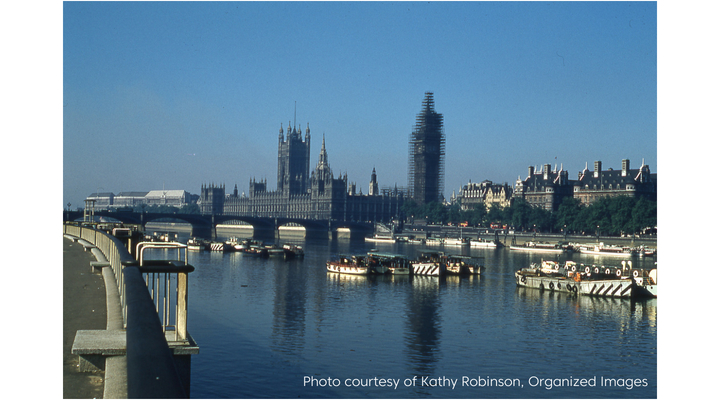
When was Big Ben under restoration?
Cheryl DiFrank, My Memory File
“I’ve used a magnifying glass to read a few words of a newspaper headline on a desk and then googled the headline. I have also googled what football teams played each other on a certain date.”
Fashion Details
Hairstyles and clothing can help identify the approximate date of a photo. Maureen Taylor, The Photo Detective, has some great resources for dating your ancestor’s photos through their fashion.
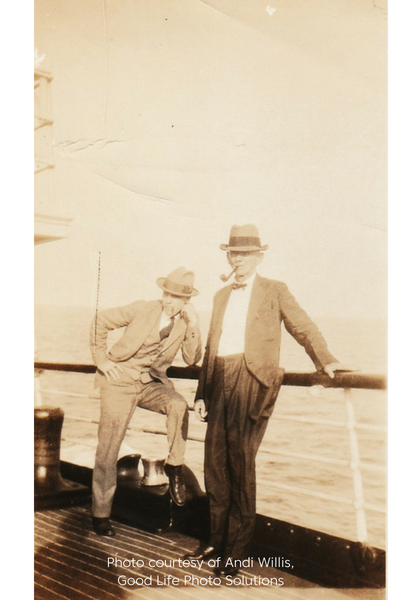
Researching these gentlemen’s clothing and hats could give you a clue to the photo’s date.
Pay attention to details like bangs (Suzie got bangs in 3rd grade so photos with the bangs are probably 3rd or 4thgrade) or braces. They may not give you a specific date, but they may help your general chronology. These are good details to add to your family timeline.
What’s Going On
If the photo shows a public event (IndyCar race, State Fair, concert), google the names of the events then look for logos that match yours. That will usually help you find the year, if not the month and day too.
Mother Nature
Take note of blooming flowers or bare trees. This will give you an idea as to the time of year.
Debbie Wiener, Got Pix
“I’ve compared several pics of a child and aged them as before braces, with braces, straight teeth! Also, house pictures (can be dated) by sizes of the trees.”
Other Supporting Documents
If you have other supporting documents such as obituaries and funeral service bulletins, they can give dates of birth, places of residence, family members and other information that can help identify photos.
Birthday party invitations with a specific theme (like Spiderman or roller skating) can give you a date when paired with photos showing the same theme.
Of course, if you have a family member (or two) that you can ask about dates, locations, and stories, they may be your most valuable resource.
Happy Sleuthing! What is your favorite tip for dating your photos?
More Dating Resources
Identifying Photographs Timeline
Dating and Identifying Your Old Family Photographs
What is That? The Rare Format Slide Guide
Quick & Easy Methods for Dating Photos

Kathy Stone, a Certified Personal Photo Organizer, founded Calgary Photo Solutions to help people preserve their photos and stories by providing a range of photo organizing services. Kathy has been helping people organize and enjoy their printed and digital photos for over 17 years. During severe flooding in Southern Alberta in 2013, Kathy saved thousands of photos for several families. She is a Certified Adult Educator, and has presented at the Association of Personal Photo Organizers Conferences in 2014 and 2016, provided digital and print photo training to numerous groups and individuals, and spoken to individuals and organizations about the importance of photo preservation
Andi Willis is passionate about helping people preserve and protect their family photos with Good Life Photo Solutions. In 2014 Andi became a Certified Personal Photo Organizer with the Association of Personal Photo Organizers. Making memories last and preserving family legacies are her primary goals when organizing a client’s priceless photos. She loves working with clients create a photo collection that is well organized, easy-to-access and ready to be enjoyed for generations to come.
Married to her husband Troy for 25 years, she lives in Georgia with two teenagers, one dog, and three cats. In her spare time (whatever that is), she enjoys reading, genealogy and watching my husband compete in triathlons. See the story of Andi’s life here.
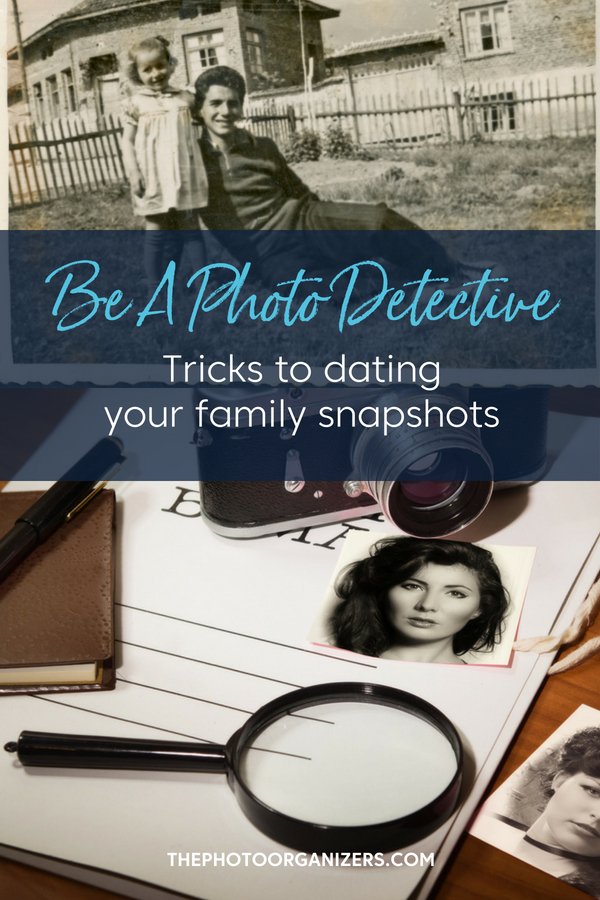



Fabulous tips! And the more you sort, the faster you get because you already have dated photos to compare to, and know what family members look like at different ages.
Yes, Karen! Good point. It does tend to get easier as you go along.
Fantastic tips! I use all of these regularly in my photo detective work.
Thanks, Adam! These are all great tips to keep in our “toolbox.”
What a great collection of resources for photo sleuthing!
Thanks, Laura! And thank you for contributing your tips.
I love the tips and information for Photo detectives. This is something my clients need to understand.
Thank you
The more we share with them, the easier our job becomes. Right, Judy?
Great tips Andi! I absolutely love taking pictures and looking at them, but who doesn’t? What I enjoyed most about this blog was how you referenced using dates. I posted a blog a few years ago about creating a memory box to store special cards, and what’s so great about dating cards and pictures, is having the ability to take a trip down memory lane. I do this with cards faithfully, and it’s a fantastic way to reflect back at a card you received when you were in elementary school. Thank you for sharing your knowledge with us!
You are welcome! When my kids were little, I tried to remember to write a date on the back of any special cards or schoolwork that I was going to keep. It was invaluable this Spring when I made a special photo book for my daughter’s high school graduation.
I am having fun looking at all of these old photos. My funny story is that my camera’s date (back in the day film camera) somehow got messed up. All of my photos for years printed the wrong date, and I didn’t know how to fix it. I laugh now because I know all of these dates are wrong. My grandmother used to handwrite the date on the white margin of her prints. Not a bad solution, although I’m sure not great for the photo. At least we know the details!
Those camera dates can be tricky, for sure! As long as your family member didn’t write directly on the main part of the photo (like my mother did!!), I think you are fine. You can always crop that out if you want.
Wow, so much great information! I’ll definitely come back to this the next time I’m going through that old box of family photos!
Thanks, Janet! I’m glad you found it helpful.
I love these tips and tricks to figure out the dates of photos! I wish I had them years ago when I was trying to pinpoint the dates on some photos of mine. All my photos are not dated when I was growing up. It took me a long time to figure out what time frame.
It’s always a struggle, Sabrina. If any new old photos come into your life, you’ve got these tips in your back pocket. Thanks for reading.
What about the date that is placed on the back of some photos? Are these considered to be accurate, since I would think the date is placed by a professional developer? Course an individual sets the date.